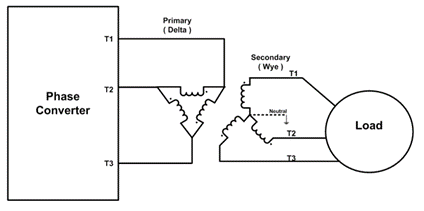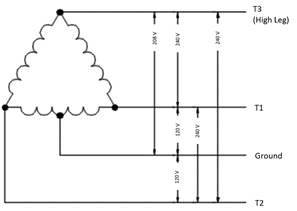Phase Converter FAQ
General
- Q: What is the difference between a phase converter and a variable frequency drive (VFD)?
- Q: Why are my lights flickering when the equipment is running and how do I remedy it?
Phase Converters
- Q: Why would I choose a Phase Perfect digital phase converter over a rotary converter or static converter?
- Q: How do I size a phase converter?
- Q: Can I run multiple loads with one phase converter?
- Q: What is the difference between delta configured and wye configured power?
- Q: Can I use a digital phase converter to run equipment that requires a neutral.
- Q: Can a phase converter change the voltage and frequency?
- Q: What size wires will I need for my phase converter?
- Q: How often do I need to change the capacitors in my phase converter?
- Q: Why is the output voltage on one leg of my 240 V phase converter 208 V to ground?
- Q: Can I use a phase converter with a backup generator?
- Q: What size generator do I need?
General
Q: What is the difference between a phase converter and a variable frequency drive (VFD)?
A:Phase converters provide three-phase, 60 Hz power like what a utility would provide and can be used to power machines that have internal electronics that control motor speed. Variable frequency drives are used to vary the speed of electric motors.
Q: Why are my lights flickering when the equipment is running and how do I remedy it?
A: This phenomena is called electromagnetic interference (EMI) and is typically caused by poor grounding or wire routing. A poor electrical ground doesn’t allow high frequency noise to easily travel to ground, causing interference on other circuits. Additionally, if power lines are routed near adjacent wiring, high frequency noise can be radiated onto nearby wires, causing interference. An EMI filter can sometimes eliminate EMI but the ideal method is to address grounding and wiring issues. See Phase Technologies’ recommendations to mitigate EMI here: https://www.phasetechnologies.com/download/category/104-mitigating-led-flicker
Phase Converters
Q: Why would I choose a Phase Perfect digital phase converter over a rotary converter or static converter?
A: There are two main reasons to choose a digital phase converter over other options. Phase Technologies’ digital phase converters offer line-to-line voltages that are balanced within 2%. This means your equipment runs better and lasts longer. The second reason to choose a digital phase converter is reduced standby power consumption. Compared to rotary converters, digital phase converters consume very little power in standby mode and will save you money on your electric bill. Although digital phase converters are more expensive than other types of converters, the additional cost is usually offset by electricity usage within a couple of years.
Q: How do I size a phase converter?
A: Determine what equipment you will be running and look at the Full Load Amp (FLA) rating or Service Factor Amp (SFA) rating. You can run multiple loads simultaneously as long as the total amp draw of all pieces of equipment is less than the rated output of the phase converter.
Q: Can I run multiple loads with one phase converter?
A: Yes, as long as the total amp draw of the equipment, that will be running at the same time, is less than the output rating of the phase converter.
Q: What is the difference between delta configured and wye configured power?
A: Delta-configured power has four wires: three hots and a ground. Wye-configured power uses five wires: three hot wires, one ground, and one neutral. Phase converters will provide delta-configured power. If your intended load requires wye-configured power, you will need a delta-to-wye transformer on the output of the phase converter to power the load.
Q: Can I use a digital phase converter to run equipment that requires a neutral.
A: Yes, but the output of phase converters is delta-configured, meaning it has no neutral line. You will need a delta-to-wye transformer on the output of the phase converter to generate a neutral leg to power your equipment. See figure below.

Figure 1 – Delta-Wye Wiring Diagram
Q: Can a phase converter change the voltage and frequency?
A: No the output voltage will match the incoming voltage and can only be used at 60 Hz. (50 Hz optional at time of order)
Q: What size wires will I need for my phase converter?
A: Phase Technologies provides recommendations for input wiring in every product manual, but output wiring is based on the application. Consult a licensed electrician to ensure that your installation complies with national and local electrical code requirements.
Q: How often do I need to change the capacitors in my phase converter?
A: Line filter capacitors should be checked once a year as described in the product manual and should typically be replaced every three years on Phase Perfect® units produced prior to 2019. Newer units should still be checked annually, however, the Phase Perfect® now uses film type line filter capacitors that should see a longer service life.
Q: Why is the output voltage on one leg of my 240 V phase converter 208 V to ground?
A: For a phase converter to generate three-phase power, the two incoming power lines are directly passed through to the output and the phase converter generates the third leg in a configuration known as “high-leg delta.” This will power most three-phase machines. Some machines however require wye-configured power, which includes a neutral. If your machine requires wye-configured power, you will need to send the output of the phase converter through a delta-to-wye transformer before the load. In the graphic below, T3 is the generated leg.

Figure 2 – High Leg Delta
Q: Can I use a phase converter with a backup generator?
A: Yes, but this will also require setting up a delay timer for 20-30 seconds before power is transferred between utility power and the generator. Not using a delay timer can cause PLL Faults or damage to the converter that is not covered under warranty.
Q: What size generator do I need?
A: The generator should be rated for at least 1.5 – 2 times the current rating of the phase converter to properly run a load.